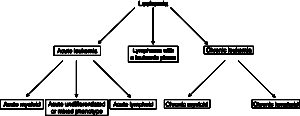At Cornell University, we distinguish (whenever possible), three main types of leukemia:
1) Acute leukemia: Consisting of undifferentiated or poorly differentiated cells. These can be acute myeloid or lymphoid in origin, display markers of myeloid and lymphoid lineage (mixed phenotype) or lack lineage markers (undifferentiated);
2) Chronic leukemia: Consisting of differentiated cells that can be recognized by morphologic features. These can be myeloid or lymphoid in origin; and
3) Lymphoma with a leukemic phase: Neoplastic cells from a lymphoma that is arising in an extramedullary site is present in blood and/or bone marrow (Stage V disease). In World Health Organization classification criteria, some forms of lymphoid neoplasia are classified as leukemia/lymphoma, e.g. mature cell neoplasms (chronic lymphocytic leukemia/small cell lymphoma) and precursor cell neoplasms (lymphoblastic leukemia/large cell lymphoma). Distinguishing between an acute or chronic lymphoid leukemia and lymphoma can be difficult and is based on the main site of involvement: Blood or bone marrow for leukemia and extramedullary tissue for lymphoma.

